People who witness a tornado never forget. They may recall awe and beauty, or awe and terror, depending on their vantage point. Either way, they will be awed and it will haunt them forever.
For many, it becomes an obsession. An obsession to watch, film, chase, drive beneath – a need to understand. Or else, an obsession to hide every time the wind howls.
A tornado is nature’s demon. Winds in rotation, tight as a knot, with a body and energy that give it life, coherency, and a dislike for trailer parks. Most terrifying of all, it will chase you down, suck you off the ground and spit you back naked, muddy and dead.
That’s demonic.
It’s size and power seems to materialize from thin air. And it does. It’s nothing but air, at least until it picks you up, along with tons of dirt, cars, buildings and cows. All are then part of the coherent, rotating structure.
But is it really just air, spinning like a top – or is there something too organized about the mayhem – something we still don’t know?
The Mystery…
 No one fully understands tornadoes. Scientists and weather nerds chase them all over the Midwest every spring; they can’t hide. So what’s the mystery?
No one fully understands tornadoes. Scientists and weather nerds chase them all over the Midwest every spring; they can’t hide. So what’s the mystery?
There are a few, but the primary one is how this coherent mass of rotating air gets vertical and ‘descends’ itself to the ground.
Tornadoes are believed by consensus science to be a purely thermodynamic event, caused by convection of moist, warm air into cold jet streams above, and the shear winds and condensation that results.
It’s no reach to understand how shear winds generate rotation, but the shearing in thunderstorms tends to be drafts traveling up and down, and cross winds at different elevations. Either shear can produce rotation, but only in the horizontal plane.
The theory approved by consensus science for grade school education, is that the column is created by shearing horizontal winds, one over the other, that create a horizontal rotating mass that gets lifted and stretched by updraft winds into a vertical vortex. What they don’t tell the grade-schooler’s is that the physics doesn’t work.
To illustrate the issue, think of a similar vortex, like a whirlpool in a bucket of water. If you stir the water with a spoon near the surface of the water, at first no whirlpool appears.
Keep stirring…
After awhile, when you have water rotating at the top of the bucket, the vortex forms. But it won’t extend any deeper than where the water is rotating. It won’t reach bottom until the rotation translates downward and the whole bucket of water is spinning.
 If you want to make a whirlpool fast, put the spoon all the way down and stir at the bottom of the bucket. Then it forms quickly, like opening a drain. To ‘descend’, the vortex needs to be pulled down by the low pressure created by centrifugal effects of the rotating water around it. If the bulk body of water around the vortex isn’t rotating, the funnel loses coherency and dissipates.
If you want to make a whirlpool fast, put the spoon all the way down and stir at the bottom of the bucket. Then it forms quickly, like opening a drain. To ‘descend’, the vortex needs to be pulled down by the low pressure created by centrifugal effects of the rotating water around it. If the bulk body of water around the vortex isn’t rotating, the funnel loses coherency and dissipates.
What is really happening is the vortex is created at the bottom of the bucket when you stir, and the funnel descends to meet it. The vortex has to be there first, and made to spin faster to draw the void of air down, which is the funnel we see.
So, one might ask, isn’t the funnel sucking like a straw and pulling itself down a column of air like a climber on a rope? Does your vacuum cleaner hose pull you down when you hold it a foot, or so above the ground?
No, there is nothing for it to pull on. The air beneath the hose keeps getting replaced as fast as it’s sucked in, so there is no tension created. A sufficient low pressure region can’t develop beneath the hose to provide any force unless you hold it less than an inch away from the ground, where friction can slow the inflow and generate a region of low pressure between the hose and the ground.
Just like the whirlpool, there needs to be a low pressure region to pull the funnel down and vortex winds at ground level. Before a tornado touches down, these winds need to be there. But there is often relative calm before a touchdown. All hell doesn’t break loose until after.
Consensus Theory #1…
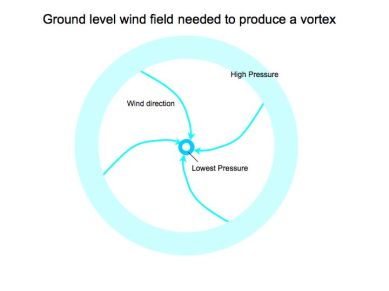
Some researchers do predict rotating ground winds initiate tornadoes. The appearance of descent is really not the swirling winds of the tornado, but the visible condensation forming in the low pressure inside the vortex, and this condensation descends as the vortex ‘spins-up’, rotating faster.
In this concept, the tornado’s wind is already there in a compete column surrounding the descending condensation. It’s thought the tornado is initiated by a ground level vortex wind and this ground vortex controls the spin of the tornado.
Inflowing ground winds are certainly in the equation during the tornado’s life. But before touchdown, the existence of a ground vortex hasn’t been verified. It’s thought to be at low wind speeds, below speeds that would cause damage. It’s not until this ground vortex spins itself-up enough to start lifting dust that the tornado technically ‘touches down’ and we notice it.
The issue with this theory is that rotating funnel clouds are commonly seen that never seem to touch down at all, or be associated with ground winds, which implies they are rotating up there by themselves caused by something other than a ground vortex. This puts tornadogenesis back in the clouds.
Even in the event a subtle ground vortex is involved in creating a rotating column, how does this ground vortex form? Data is lacking because no one can predict where a tornado is going to land in order to set up the instrumentation.
Consensus Theory #2…can it still be a consensus?
 Another theory proposes that the vortex is drawn to the ground when a descending column of air and rain wraps around a funnel cloud.
Another theory proposes that the vortex is drawn to the ground when a descending column of air and rain wraps around a funnel cloud.
It’s called an occlusion downdraft, and it’s commonly seen, but not always. The theory requires the rainy downdraft wrap around the funnel to form a concentric vortex that merges with the funnel cloud and creates a smoke ring effect, a torus of rotating winds, with a longitudinal momentum that drags the funnel down. No photographs of this torus exist, as far as we know.
It sounds like a complex process. Too complex to explain several types of tornado that form when the mechanisms required aren’t there. Non-supercell tornadoes, albeit typically weaker, form when the conditions required for rain-wrap aren’t present.
Strange behavior…
Non-supercell tornadoes are circulations that do not form from organized storm-scale rotation. These tornadoes form from a vertically spinning parcel of air already occurring near the ground.
One non-supercell tornado is a landspout. A landspout is a tornado with a narrow, condensation funnel that forms while the storm clouds are still growing and there is no rotating updraft – the spinning motion originates near the ground.
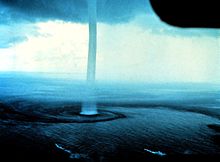
Waterspouts are generally classified as non-supercell tornadoes. Waterspouts have a five-part life cycle: a dark spot on the water surface, spiral pattern on the water surface, a spray ring around the pattern, a visible condensation funnel, and ultimate decay.
Again, the life cycle begins at the surface, when a “dark spot” forms. They normally develop as their ‘parent’ clouds are still in the process of development.
Waterspouts are known for raining fish. From as deep as three feet below the surface (how do they know this?) fish can be lifted into the air and deposited as far as 100 miles inland.
Tornadoes display other perplexing behavior. Witnesses claim seeing tornadoes die suddenly and another rapidly form in apparently the same track as the previous.
 Did they see one tornado fluctuating in strength, or two vortexes in sequence? The disappearance and reappearance is so rapid it is hard to imagine the atmospheric dynamic that would cause it.
Did they see one tornado fluctuating in strength, or two vortexes in sequence? The disappearance and reappearance is so rapid it is hard to imagine the atmospheric dynamic that would cause it.
Mounting evidence, including Doppler mobile radar images and eyewitness accounts, show most tornadoes have a clear, calm center with extremely low pressure, like the eye of a hurricane. The mystery of this is why it surprises anyone, but it’s still fascinating.
What follows is an excerpt from a 1930 report by Mr. Will Keller of Greensburg, Kansas, eye witness to the inside of a tornado:
“Steadily the tornado came on, the end gradually rising above the ground. I could have stood there only a few seconds but so impressed was I with what was going on that it seemed a long time. At last the great shaggy end of the funnel hung directly overhead. Everything was as still as death. There was a strong gassy odor and it seemed that I could not breathe. There was a screaming, hissing sound coming directly from the end of the funnel. I looked up and to my astonishment I saw right up into the heart of the tornado.
There was a circular opening in the center of the funnel, about 50 or 100 feet in diameter, and extending straight upward for a distance of at least one half mile, as best I could judge under the circumstances. The walls of this opening were of rotating clouds and the whole was made brilliantly visible by constant flashes of lightning which zig-zagged from side to side. Had it not been for the lightning I could not have seen the opening, not any distance up into it anyway. Around the lower rim of the great vortex small tornadoes were constantly forming and breaking away. These looked like tails as they writhed their way around the end of the funnel. It was these that made the hissing noise.
I noticed that the direction of rotation of the great whirl was anticlockwise, but the small twisters rotated both ways – some one way and some another. The opening was entirely hollow except for something which I could not exactly make out, but suppose that it was a detached wind cloud. This thing was in the center and was moving up and down.”
There are other types of tornado-like phenomena. Gustnado’s that form at storm fronts display the characteristics of a tornado touchdown, kicking up dust and debris in a vortex on the ground, but without any apparent rotation, or funnel above.
Sometimes without even clouds above. Dust devils also form this way. Isn’t there a common dominant influence underlying all these atmospheric whirlpools?
Now let’s remember that we live on an Electric Earth…
Take the blinders off, and see if there is another way to look at tornadoes.
By taking blinders off, it means adding electromagnetism back into the picture. It has been excluded almost completely by consensus science, even though it is the most pervasive feature of thunderstorms – the very things that makes tornadoes.
The word tornado is an altered form of the Spanish word tronada, which means “thunderstorm”. This in turn was taken from the Latin tonare, meaning “to thunder”. So even the etymology recognizes the obvious, fundamental connection that many, in influential positions, miss. With that in mind, let’s digress a moment to discuss lightning.
Atmospheric Circuitry…
We don’t notice what’s happening electrically in our atmosphere, because we live on the earth’s surface in an equipotential layer. We don’t notice, that is, until a thunderstorm arrives.
Our atmosphere carries an electric field. The atmospheric field varies widely – from night-to-day and summer-to-winter – between 100 volts per meter vertically in clear weather, to orders of magnitude stronger during thunderstorms.
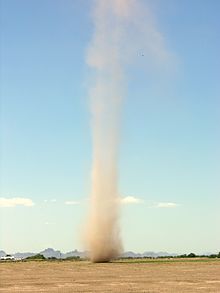
For example, dust devils have been researched by very dirty scientists who measured a vertical electric field gradient of 10,000 volts per meter, even in small whirlwinds. They also found them to produce radio noise and a fluctuating magnetic field at frequencies of 3 to 30 Hz.
Since no intrepid storm-chaser has yet stood under a tornado with an antenna and voltmeter (not for lack of trying) we don’t know the potential in a tornado. Assuming an average tornado column to be three km long and carrying the same potential gradient over the column, that would be a 30 million volt potential. That’s two and half million car batteries connected in series.
A strong electric field will lift materials off the ground and into the atmosphere. Field experiments indicate that a large dust devil measuring 300 ft across can lift about 15 tons of dust into the air in 30 minutes.
Electricity is also known to aid formation of sand storms on Earth, and NASA believes it to be instrumental in raising dust on the Moon, dust devils on Mars, and tornadoes in the atmosphere of the Sun.
Normally the atmosphere carries a minor fair weather current of one pico-amp per square meter. This tiny current is thought to be a return current caused by lightning around the world, diffused throughout the atmosphere. This tiny, diffuse current is only part of the return circuit in a lightning bolt, however.
Keep stirring…
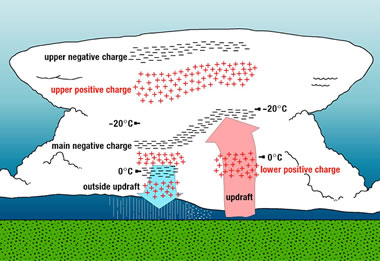
Lightning from a thunderstorm has no ‘electrode’ in the sky. It comes from accumulations of charge in the clouds – pools of electrons, or ions, like the accumulated charge on a capacitor plate.
Temperature and pressure moved by shearing winds take the place of the plates in segregating regions of charge.
A study using interferometer and Doppler radar to correlate lightning with updraft and downdraft winds, showed that lightning avoids the updraft core (red arrow in the image) and forms in regions of weaker, lower pressure winds around the updraft. As a storm intensifies and the updraft speeds up, lightning frequency dramatically intensifies.
Fast updraft winds and their role in supercell structure is a discussion for another day, however it will be shown they are likely motivated by electric current in the storm in the first place, so it is not surprising in an electric atmosphere that positive ions in a powerful updraft would collect negative charge around the updraft column, which is where the study found lightning to initiate.
 Updraft winds don’t produce much lightning until they reach 10 to 20 mph. Then strike frequency escalates with updraft speed. From 20 to 50 mph wind speeds, lightning frequency might be 5 to 20 strikes per minute, whereas above 90 mph, the flash rate can exceed one strike per second.
Updraft winds don’t produce much lightning until they reach 10 to 20 mph. Then strike frequency escalates with updraft speed. From 20 to 50 mph wind speeds, lightning frequency might be 5 to 20 strikes per minute, whereas above 90 mph, the flash rate can exceed one strike per second.
It’s like a motor running.
Coincidentally, cloud-to-ground lightning frequency is seen to decrease as a tornado touches down, and return to the baseline level when the tornado dissipates. This is an important point, but we’ll return to it later.
The charged layers in the cloud, and the thin, flashing filament we see in common cloud-to-ground lightning, is only part of the event. There is also buildup of positive charge on the ground. The ground charge forms as a pool of positive ions over the surface of the land and its features, accumulating in concentration at high points. The positive ions form when electrons are stripped away from air and surface features by the powerful electric field.
The lightning bolt initiates when the negative charge invades the air below with filaments of charge called leaders. Remember, there is an amplified electric field of millions of volts between the storm clouds and Earth. The leaders zig-zag downward in stepped segments while the ground charge reaches up in a filament of positive ions called a streamer. When leader and streamer meet, the channel is complete and dumps the negative cloud charge to ground. This is called an arc discharge.
Electrons flood through the channel at relativistic speed, creating a magnetic field that constricts the channel and the current, called a z-pinch. It is the dielectric breakdown of atmosphere to allow a discharge – a short circuit between the clouds and ground.
The ionic ground charge follows, ions being heavy and therefore slower than electrons, rushing up the channel at 60,000 miles per second in what is called a return stroke. It’s the return stroke we see emitting light from particle collisions in the constricted channel. Return strokes often repeat as new charge pools and discharges, producing multiple flashes until charges equalize.
It all happens within tenths of a second, involving volumes measured in cubic kilometers. So these charged layers in the clouds and on the ground must be highly coherent.
Dark – Not Arc…
Arc discharge is the extreme end of the spectrum for electrical discharge, however. There are other types of discharge that occur under different regimes of electric field intensity, charge density, and the polarity and physical properties of the electrodes and medium the discharge takes place in.
The channel lightning travels in is a fully ionized plasma generated by the strong electric field between the cloud and ground. The leaders and streamers are the plasma channel being created. Other modes of current flow can occur without dielectric breakdown, or full ionization of the plasma. These currents don’t create an arc of lightning.
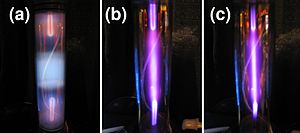
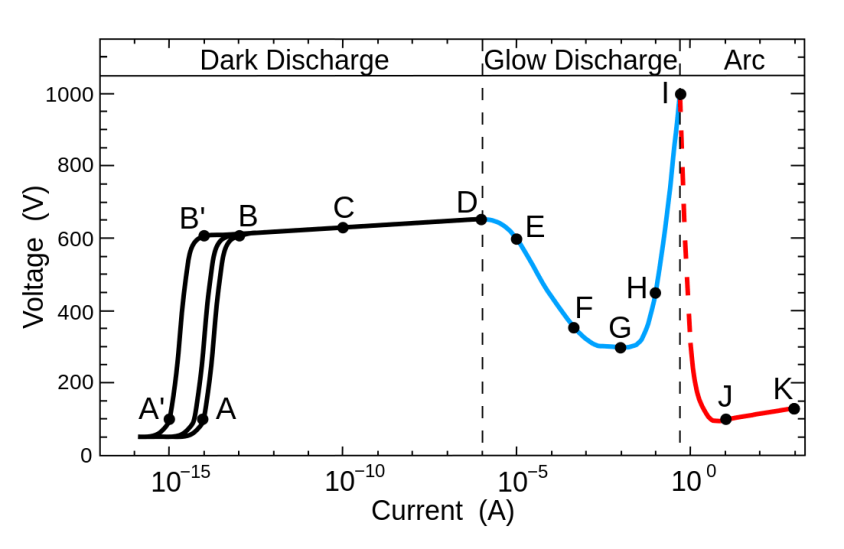
From ‘A’ to ‘B’ is a regime of discharge initiation, where reactions are taking place to saturate the channel with ionization. Then from ‘B’ to ‘D’, current rises exponentially with very high voltage. Current density is low enough though, there are few particle collisions and it emits no visible light. This is the regime of dark discharge, or dark current mode, and it’s invisible.

In this region, the high electric field gives electrons enough energy to ionize a neutral atom, releasing another electron which initiates a chain reaction. The new free electron ionizes another neutral in a secondary reaction and this continues, leading to an avalanche of new ion and electron production. The avalanche results in the exponential current rise as charge density amplifies. It’s called a Townsend discharge.
When current is high enough, visible glow can occur near the electrode and edges, sharp points, or other narrow objects where charge collects. This is called corona discharge. One form of corona discharge is St. Elmo’s fire.
Another glow discharge related to corona discharge is dielectric barrier discharge between two parallel plate electrodes. Both occur at high voltage, low current in atmospheric air below the dielectric breakdown threshold, and without the explosive blast and temperatures of an arc.

A dielectric barrier discharge, shown above, demonstrates how current collects itself into plasma streamers. The discharge is occurring in air between two parallel electrode plates layered with mica at about 30 kHz, with a discharge gap of about 4 mm. The wide foot of the discharge is ionic charge pooling on the barrier surface.
Cold, Dusty Plasma…
For air to become plasma and carry current, the air has to be partially ionized. A plasma state can be defined by “plasma density” – the number of free electrons per unit volume, and the “degree of ionization” – the proportion of atoms that have lost, or gained electrons.
Even a partially ionized gas in which as little as 1% of the particles are ionized is considered a plasma, responding to magnetic fields and displaying high electrical conductivity. A partially ionized plasma is often referred to as a “cold plasma”, and highly ionized plasma is referred to as “hot”.
A negative corona begins with an ionization event, such as a pooling of ions in a strong electric field generating primary electrons, followed by an electron avalanche. Secondary electrons are created by photoelectric effect at the electrode.
Corona discharge will produce dark current by generating the electrons and ions in a current flow that has a particular geometry. The glowing region that halos around the point electrode is where primary ionization occurs. The charged species then enter a ‘drift’ region where they follow the electric field, but are dispersed by charge repulsion in a spray, like a wonky shower-head.
It’s in this region secondary ionization occurs. If electrons/ions have enough oomph from the electric field, the secondary reactions will continue to occur, maintaining a current to the plate electrode. If not, they recombine with positive ions and neutralize, extinguishing the current.
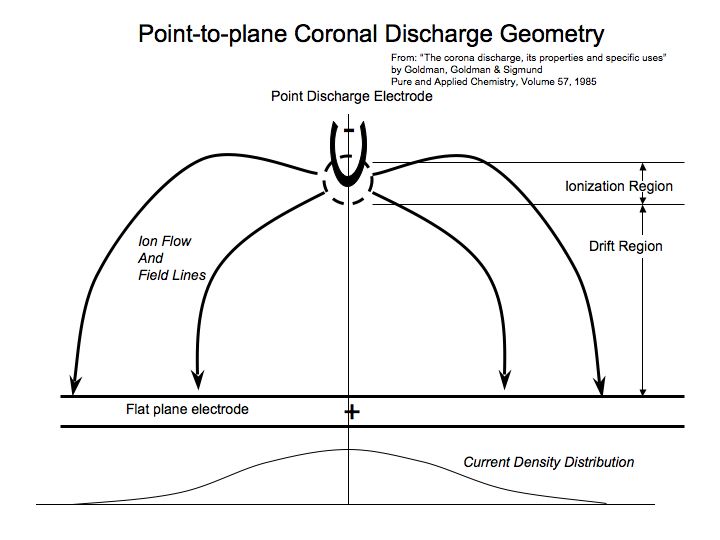
The center of the coronal discharge is more energetic and isolated from interaction with surrounding particles of opposite charge, so more often cascade into avalanches. Closer to the edge of the discharge, weaker reactions manifest in transfer of momentum and heat between the ions and neutrals. This causes a current density distribution, as shown by the curve at the bottom of the above diagram. The current segregates into channels oriented to the distribution.
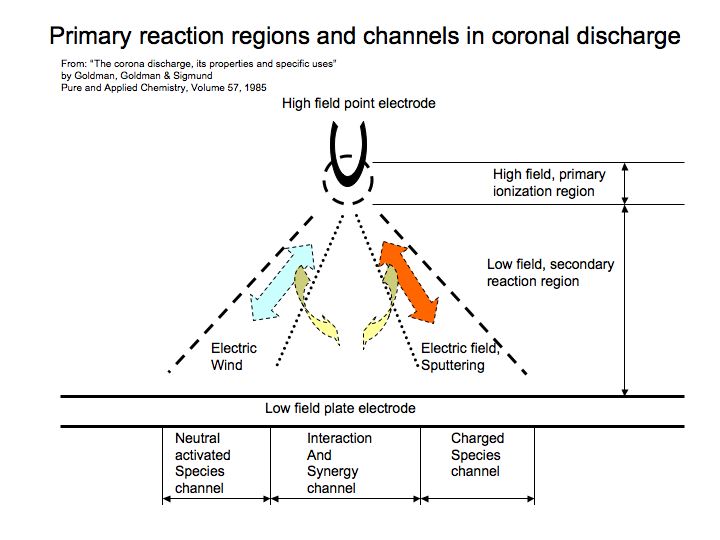 The geometry in a negative corona is three concentric regions of emission. The inner region, corresponding to the peak distribution of charge density, is ionizing plasma where high energy primary electron-neutral collisions avalanche. The intermediate ring is a non-ionizing plasma where electrons collide with neutral oxygen and water vapor with insufficient energy to avalanche, but produce a plasma of primarily negative ions that drift to the flat plate electrode and complete the circuit. The outer region is a flow of negative ions and sparse electrons known as the unipolar region.
The geometry in a negative corona is three concentric regions of emission. The inner region, corresponding to the peak distribution of charge density, is ionizing plasma where high energy primary electron-neutral collisions avalanche. The intermediate ring is a non-ionizing plasma where electrons collide with neutral oxygen and water vapor with insufficient energy to avalanche, but produce a plasma of primarily negative ions that drift to the flat plate electrode and complete the circuit. The outer region is a flow of negative ions and sparse electrons known as the unipolar region.
These regions correspond well with the anatomy of a super-cell, assuming charge accumulates around, or near the central updraft that breathes life into the storm.
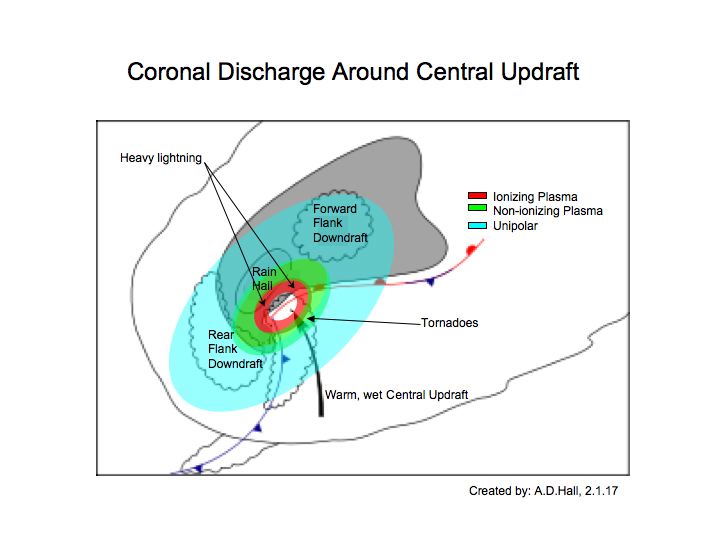 The Ionizing Plasma Region…
The Ionizing Plasma Region…
Directly beneath the core of the corona, avalanches can be energetic enough to establish sputtering arcs. We see it as negative cloud-to-ground lightning, which observations concur, happen around the updraft and with a frequency regulated by the updraft speed.
The Unipolar Region…
The uniplolar region is the outer ring of the corona. It’s not a plasma, but is composed of a low density of negatively charged ions drifting towards the plate electrode, transferring energy primarily as heat and momentum rather than electrical current. Momentum transfer manifests as downdraft winds by the process of electrokinesis.
Electrokinesis is the transfer of momentum from the charged particles to the surrounding neutrals, creating an ‘electric wind’ that moves the bulk fluid along the electric field. Air ionizers and blade-less fans work by electrokinesis, by partially ionizing air in the same fashion, with a coronal discharge.
In humid air, ions will also be hydrated causing selective water transport. Therefore, unipolar drift manifests in a thunderstorm as the forward (FFD) and rear flanking (RFD) downdraft winds, rain and hail.
The Non-ionizing Plasma Region…
The intermediate channel of non-ionizing plasma generates ions at low energy that precludes avalanche, but carry current as these ions drift to the plate. If the ionization rate exceeds the rate of recombination, the plasma will build a tendril (actually called a streamer, but we’ll use the term tendril to distinguish it from a lightning streamer) from the point electrode to the plane electrode (earth) pushing the plasma generating ionization region ahead of it, and drawing behind it a cloud of cold plasma. When this plasma hits the plane electrode a cathode spot is produced, and the electric field redistributes along the plasma channel that is created.
The Tornado…
The cathode spot on the ground (plate electrode) draws positive charge to it, dragging neutrals by electrokinesis, and creating the in-flowing winds that generate a vortex. This is the moment of touchdown, as charged air and dust flow in and spiral upwards around the invisible plasma tendril.
The action is analogous to the lightning bolt leader and positive ground streamer that meet to create a channel for arc discharge, only in this case the plasma channel is partially ionized, diffused with predominately neutral species. Its energy and charge densities are too low to make an arc, so it forms a complex plasma channel called a Marklund Convection.
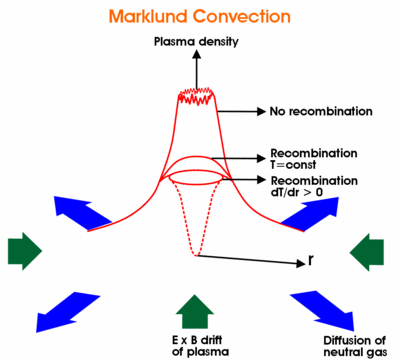
Rotation is a natural consequence for two reasons. Neutral air is diffused away from the Marklund current creating low pressure. But positive ions near the ground drag air, dust and debris to the ground contact and create in-flowing winds and a sudden change in direction up, and around the tendril. The meeting of these opposing winds is, by definition, a vortex.
But current in plasma will itself rotate, taking a helical path as it interacts with the magnetic field around it. The appearance of a tornado is precisely what one would expect from such a current. Increasing current flow “spins up” the tornado.
It forms an inner spiraling negative current to ground and an outer spiral of positive ionic wind flowing up to the source of coronal discharge.

Because the tornado is a cold, partial plasma carrying a significant mass of neutral air and dust, it can be pushed by winds to create a slanted, or even kinked path, and travel away from it’s point of origin.
Now let’s return to the storm that most often creates tornadoes. Super-cell morphology provides all the effects of corona discharge. The super-cell has distinct regions of updraft and downdraft winds (electrokinesis), rain and hail (water transport) and sputtering arcing discharge (lightning) which we discussed earlier, forms around the central updraft.

Evidence…
If tornadoes are caused by coronal discharge generating a Marklund convection current from cloud-to-ground, what are some tell-tale signs?
Wall clouds…
One piece of evidence may be the wall cloud. Wall clouds form before a tornado in typical supercell evolution. It will develop rotation and sometimes its clouds can be seen to rise and fall in an agitated manner. Puffs of low level clouds are drawn to it below the main cloud base.
It creates a vertical wall of cloud that is incongruous to the general slant of the storm cloud and winds in-flowing to it.
This may be evidence of the vertical orientation of the electric field created by the coronal discharge and ions transported down with moisture. The electric field doesn’t pay attention to the wind.
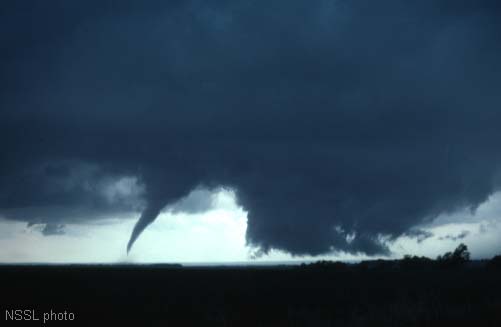 The funnel cloud doesn’t always emerge from the center of the wall cloud, as shown in most consensus science diagrams. The tornado funnel often appears along the edges of the wall cloud, or from the surrounding clouds.
The funnel cloud doesn’t always emerge from the center of the wall cloud, as shown in most consensus science diagrams. The tornado funnel often appears along the edges of the wall cloud, or from the surrounding clouds.
This is because the tendrils of current are mobile on the negative electrode and can wander. They can also multiply, creating several tornadoes.
Characteristic of parallel currents, multiple tornadoes stand off from each other as if repulsed like two parallel wires flowing current in the same direction. Rare occasions when tornadoes seem to merge, it may be that one simply dies as the other steals it’s current.
The sudden disappearance and reappearance of tornadoes, and the reported skipping, or lifting they seem to portray, are likely caused by pulsating current from an unstable coronal discharge that weakens until recombination steals the current, and then revives when the rate of ionization again overcomes the rate of recombination and a complete circuit to ground is reestablished.
Tornadoes and lightning…
As mentioned earlier, lightning frequency is highest around the central updraft and increases in frequency with the strength of the updraft winds. The central updraft of warm moist air carries positively charged ions and dust particles into the center of the storm. A negative corona might be expected to form around this updraft, attracted to the positive current generated, excited by the electric field and collisions with neutral atoms.
The physics of coronal discharge studied in the lab is generally done with point, or wire electrodes that have a constant position and shape. An electrode formed in the clouds probably forms an amorphous ring structure around the in-flowing central updraft, where charge densities can migrate.
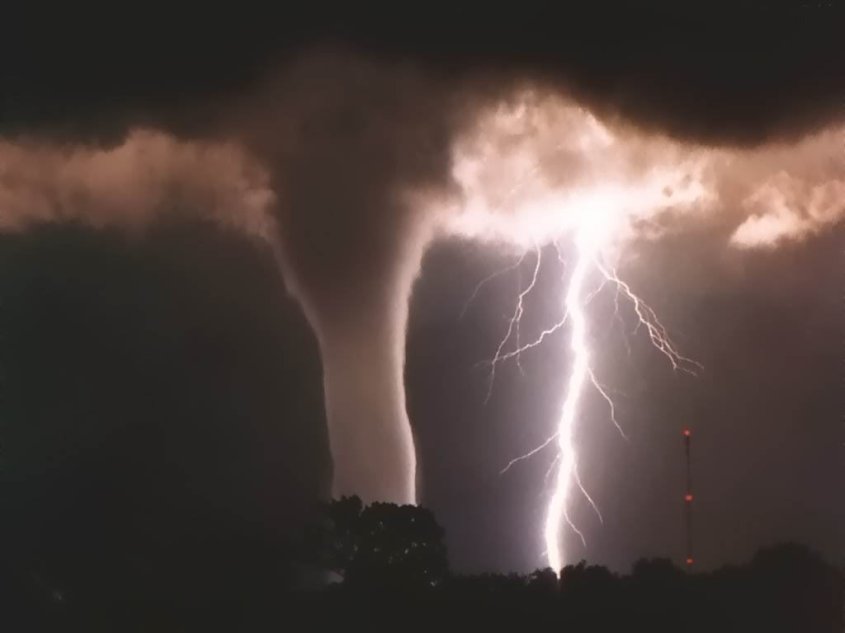
When a tornado forms, it’s been noted that cloud-to-ground lightning frequency diminishes until the tornado dies, and then it picks-up again to the baseline level. This is evidence the electric field has re-aligned along the Marklund convection in the non-ionizing plasma region, sapping energy from the ionizing plasma that manifests lightning and migrating it to the outer portion of the ring.
Sights, smells and sounds…
Tornadoes are formed by a cold plasma, dark current, so light emissions aren’t evident, at least below the clouds. Storms that produce tornadoes are often characterized by a greenish tint in the clouds, however. The green tint is excused by many scientists as a reflection of city lights, and their search for green-tinted city lights continues. The green glow of a coronal discharge internal to the cloud formation explains the green tint.
Luminosity in the clouds and the funnel are also reported. Consensus science blames this on misidentified sources of light from lightning, city lights, or flashes from downed power lines. Some of it no doubt is, but some of it is likely the effect of coronal discharge. Lightning flashes don’t make a continuous glow.
Ionized oxygen can recombine to produce ozone, which has a distinctive chlorine-like “gassy smell”. As Mr. Keller’s close call with the mouth of a tornado attests, a “gassy smell” was present.
 Mr. Keller also reported he heard hissing sounds from the multiple vortex tendrils at the base of the funnel. Funnel clouds and small tornadoes are known to produce harmonic sounds of whistling, whining, humming, or buzzing bees, like electricity. As ozone is liberated it produces such a hissing sound.
Mr. Keller also reported he heard hissing sounds from the multiple vortex tendrils at the base of the funnel. Funnel clouds and small tornadoes are known to produce harmonic sounds of whistling, whining, humming, or buzzing bees, like electricity. As ozone is liberated it produces such a hissing sound.
Energized transmission lines subject to over-voltage conditions produce all of these same effects: faint luminescent glow, ozone production and it’s accompanying hiss and smell. It’s cause is coronal discharge.
Tornadoes also produce identifiable infra-sound. It’s inaudible to the human ear, but it can be felt. It can produce nausea, agitation and body heat… not that a tornado really needs infra-sound to do that.
Lightning is seen internal to the funnel, again as reported by Mr. Keller. These are likely a form of cloud-to-cloud discharges, between the counter-flowing positive and negative currents in the Marklund convection.
Tornadoes are seen to have an inner and outer column, although this is disputed by consensus scientists as another illusion. The inner column, however, is seen if the outer dusty sheath dissipates, or is blown away. This is consistent with the double wall formed in a Marklund convection.
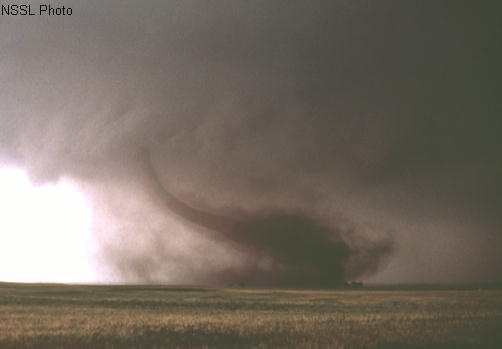
There goes Aunt Em…
A good friend who had the misfortune of being in a tornado, said he was momentarily lifted from the bathtub he was hiding in because he was weightless. He swears no wind was lifting him – he was simply weightless.
Stories from other survivors also report the sensation of momentary weightlessness, floating as if no wind was pushing. This is likely because of electrokinesis.
At ground level, the accumulation of positive charge beneath the influence of the electric field from the storm may be charging items, including people and lending them an attraction to the negative electrode overhead.
Perhaps this explains other odd events reported. For instance a house demolished, yet a table sits with a glass of water in the middle of the carnage untouched. Maybe if you don’t want to get picked up and carried away, give yourself a negative charge. Of course, too much of that can kill you, too.
Tornadoes emit on the electromagnetic spectrum as measured at a distance by researchers. Electric fields are detected and tornadoes emit sferics, the same type of broadband radio noise lightning discharges produce.
Non-super-cell tornadoes…
 So what if there is no super-cell? How do all the other vortex phenomena form – landspouts, waterspouts, gustnadoes and dust devils, and how are they related.
So what if there is no super-cell? How do all the other vortex phenomena form – landspouts, waterspouts, gustnadoes and dust devils, and how are they related.
By the same mechanism proposed here for the super-cell tornado, only in lower energy form.
Funnel clouds, which never result in a touchdown are a tendril of Marklund convection current that begins to recombine faster than it generates ions, and it dies. Landspouts, gustnadoes and waterspouts all begin with a surface disturbance – a vortex without a cloud, or at least not one showing a wall cloud, or rotation.
These may be evidence of ground contacts of the first pulse of the tendril, stimulating the ground vortex to initiate the tornado. The lack of wall cloud, rotation, or in the case of a dust devil, no clouds at all, are because the electrode is simply invisible. A dark discharge from an amorphous collection of charge in an electric field wouldn’t necessarily glow, or generate a condensation funnel.
A powerful thunderstorm creates a charged environment and elevates the electric field, regardless of whether it reaches super-cell proportions. With no organizing rotation in the clouds, the corona may very well be more like a plate electrode than a point, spread out across the sky. In this case, barrier discharge which we discussed earlier, may be closer to the mechanism that shoots tendrils without a rotating cloud overhead. Even in clear weather, thermal convection would create an updraft that could generate a diffuse corona.

This comports with the observations of twisters of all kinds, including dust devils and spouts which are seen to begin on the ground. Or water – in the case of a waterspout – where documented evolution begins with the mysterious “dark spot” on the water.
In theoretical research, not many people are even looking for electromagnetic influences except with respect to lightning. Several surveys have attempted to gain electrical data. Balloons, drones, airplanes and rockets, people in armed vehicles and stationary sounding platforms of various kinds have been deployed to take readings on tornadoes.
The extreme winds, physical danger and uncertainty in pre-positioning instrument arrays has defeated many attempts. As a result, science is relying on chasers, doppler radar and interferometers to get detailed information on wind speeds, pressures, temperatures and other physical parameters, but not so much about the ions and electric field.
Cold plasma with only a percent, or so of ionization may remain below the sensitivity of their instruments. Especially on the ground during tornadogenesis – they either arrive to late, or don’t live to tell about it. Airplanes have flown through storms and mapped clouds of electrons and ions, so we know vast sheets of charge accumulate up there.
Waterspouts were examined for electric fields. The researchers didn’t detect an unusually strong field and concluded electricity had no significant influence. There is always an electric field. Perhaps a waterspout doesn’t require as high a voltage. After all, salt water in particular, is composed of easily ionized constituents. More likely, the scientists didn’t get there on time to record the initiating pulse of the tendril, when the highest current and realignment of the electric field occurs.
We live on an Electric Earth. Weather, climate and even the land forms display it, we just need to learn how to recognize it. So, we’ll look deeper into the super-cell next time, because no one else seems to recognize it’s a thermopile!
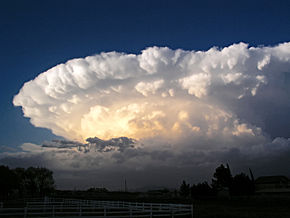




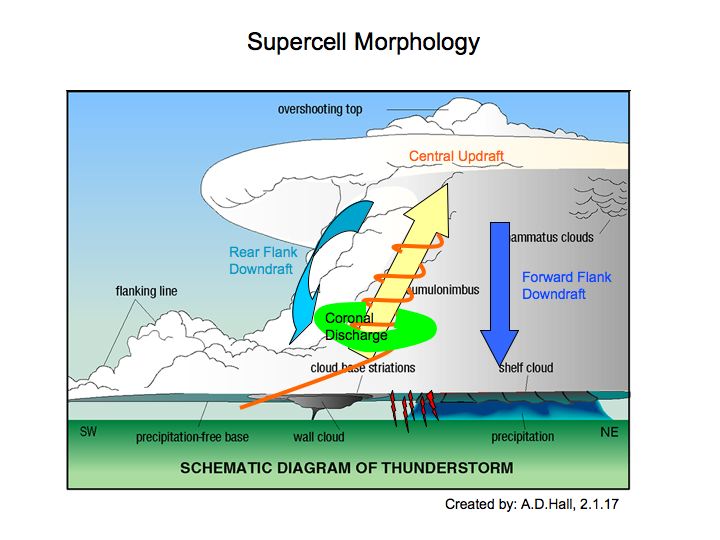
I found this because I saw a phenomenon about two decades ago. I was on the 8th floor of a Toronto office tower. It was a sunny, cloudless day. The news reported a tornado on the other side of town. This is unusual. Shortly after a serious wind blew up. It was still bright and sunny. I saw a black object flying toward me. It was a cloud but it was tiny, i guess 30 to 40 feet long. It had been torn off something large. It was jet black. And plastic. It writhed and crawled through the sky propelled by the wind. It went past me not 100 feet away. I told everyone I just saw evil. Really, I knew it was plasma torn off a tornado. But I could find no science about it. It was spooky and I wonder if I was reacting to an electromagnetic field but certainly it triggered statistic, social themes of devilish creatures moving through out human world so I tend to discount that. No, it was plasmified air produced by a tornado. There was no lighting or glow. It went right last me and was gone. The wind died down right away.
LikeLike
A superior piece of writing and analysis.Very helpful. You may find some of this info useful although you are already likely aware of it.

http://www.everythingselectric.com/marklund-convection/
http://evgars.com/flash.htm
http://evg-ars.narod.ru/new_page_6.htm
“thermal motion” to the lessons of physics on the topic “Thermal phenomena”
http://900igr.net/kartinki/fizika/Teplovoe-dvizhenie/028-Teplovoe-dvizhenie.html
LikeLike
Thanks very much for saying so. I know some of your links, but not all so appreciate your sending. Thank you.
LikeLike
Andy,
Well Done.
Jim
LikeLike